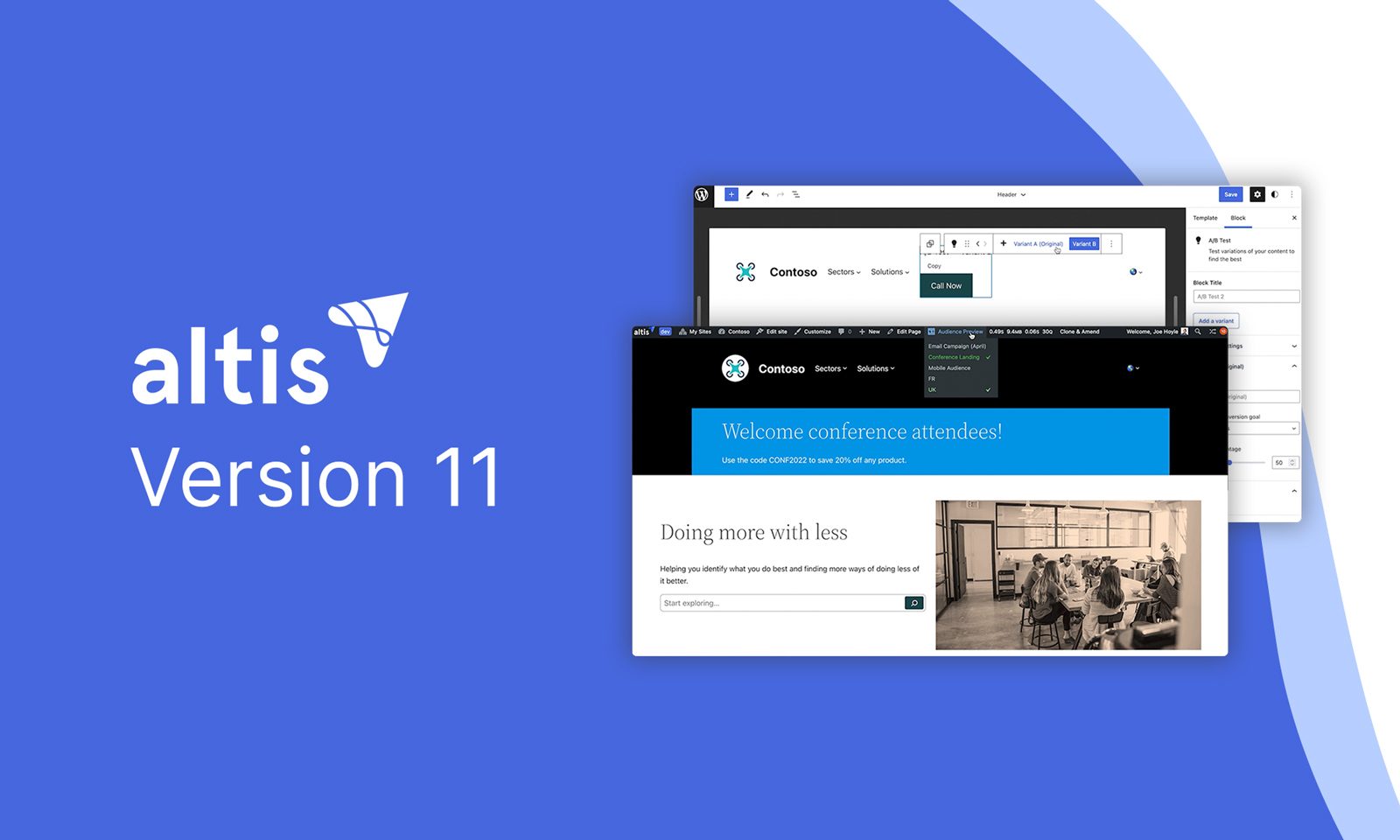
Altis v11 continues our commitment to giving marketers and editors the most advanced WordPress-powered tools to deliver digital experiences. We have introduced a new analytics processing framework, enabling businesses to combine data gathered in Altis Native Analytics with other product and business data to make more informed decisions across the customer lifecycle.
We also integrated the long-awaited Full Site Editing (FSE) feature recently launched in the WordPress 5.9 release, unlocking the power of personalized content and automated A/B testing across your entire site in ways never before possible. Though FSE is definitely a work-in-progress for WordPress, we’re really excited by what we’ve seen, and the possibilities it brings to WordPress and Altis in the near future.
Marketer Experience
Combine native analytics with customer data to fuel business intelligence
Altis v11 introduces a new framework for sequentially processing analytics data for delivery to another service.
We have integrated with Segment – the leading Customer Data Platform – empowering organizations to combine data gathered in Altis Native Analytics with other marketing, product and business data to have a unified view of their customers and drive even more relevant journeys across all platforms and channels.
A potential use case would be to combine Altis analytics data regarding page views and time clients spend engaging with different content with their CRM and product usage data. This helps businesses to make more tailored product recommendations based on a deeper understanding of client behaviour, intelligently supporting eventual contract renewal, upsell and cross-sell efforts. Read more about the Segment integration here.
Discover WordPress 5.9
WordPress 5.9 marks the largest release of Gutenberg features since 2018, enabling users to take advantage of the familiar block editor interface in more places (such as headers and footers), edit and preview the entire website directly from the editor. This provides a smoother editorial experience and empowers non-technical users to craft more effective content experiences without requiring code editing or complex workarounds.
Interested in finding out more? The WordPress 5.9 Field Guide is a great place to learn about what’s new. Here are some of the highlights:
- Block Themes and Full Site Editing, learn how to get started with FSE here
- Enhanced lazy loading performance
- Capability queries in WP_Query
- New language switcher on login screen
- PHP 8.0 and 8.1 compatibility. Although there are still some deprecation warnings with PHP 8.1, WordPress now runs on the latest versions of PHP.
Full Site Editing + Experience Blocks = personalization and A/B testing everywhere
Altis v11 includes WordPress 5.9, featuring the first preview of the brand new Full Site Editing functionality. This beta functionality allows you to edit site layout and templates just like your content, and take advantage of the block ecosystem – no development necessary! This release signals a great start to Full Site Editing and we’re excited to work with the community on its journey and evolution.
Full site editing pairs perfectly with Altis Experience Blocks, providing the ability to personalise and experiment anywhere on your site. Add banner CTAs for repeat visitors, experiment with different layouts, or display different navigation based on customer personas.
Developer Experience
ElasticPress 4.0
Instant Results featured launched in ElasticPress v 4.0
Altis v11 integrates the latest iteration of ElasticPress – bringing better performance, a new and more strict default search algorithm as well as full support for WordPress 5.9. The new Instant Results feature drives WordPress’ search experience faster than ever, powering a better user experience on high traffic sites where milliseconds of page slowdowns could otherwise negatively impact conversion rates. Read more about the important changes launched in ElasticPress 4.0.
Xdebug Profiling
When running a local server with the –xdebug flag you can set the Xdebug mode(s) to a variety of options including profiling, development helpers and so on. Previously, accessing the output from these modes required accessing the local server manually to see the files.
Starting Xdebug in profile mode using composer server start –xdebug=profile will now start up a WebGrind container giving you a UI to view profiling data from all PHP processes, including CLI and background cron tasks.
WebGrind is accessible by appending /webgrind/ to your local development site’s home URL.
In addition to WebGrind there is a new option, –tmp, that will make Local Server mount the PHP container’s /tmp directory to a directory called .tmp in your project root. This gives you full local access to any files generated by Xdebug and also can help to debug any custom code that makes use of /tmp such as temporary storage for images or other file manipulation.
Documentation Sets
Documentation sets are a layer above the existing module documentation which is currently developer focused. Currently, any /docs directory present in an Altis module, including custom modules is automatically added to the docs displayed in the WordPress admin.
Altis v11 brings the documentation into the open with a more prominent link under the dashboard and a new “User Guides” documentation set. Any Altis module (including custom modules) with a /user-docs directory will now have those docs automatically added to the user guides section. This is a great way to put guides and help for custom features within easy reach of users.
The developer docs are now only shown on Local and Development environments. User guides are shown on all environments.
HSTS Enablement by Default
HTTP Strict Transport Policy (HSTS) is now enabled by default for non-local environments. This forces devices to use HTTPS connections instead of HTTP so any reliance on non-encrypted URLs will break.
HSTS can be switched off via the Altis config by following the documentation here.
Upgrading to Altis v11
As with every Altis release, all the latest changes are fully documented in the Altis Developer Documentation. Our upgrading guide covers all the steps necessary to upgrade to version 11 – check it out.
Looking forward to v12
As always, development on Altis never stands still and we are continuing to expand the platform’s A/B and multivariate testing capabilities. Version 12 will introduce full insights on page-level experiments with the same level of granularity as marketing users currently enjoy at the block level, easily accessible within the Insights page.
For developers, we are fully integrating GitHub Codespaces, making it easier to get projects kicked off with zero configuration required.
We will be providing full support for PHP 8.0 in the upcoming release of Altis v12. This new major version provides improved code execution performance, getting rid of frequent bugs and unexpected behaviours that often plague developers. Read more about how to start preparing for PHP 8.0 and check out the PHP compatibility check guide here.
If you’re interested in testing any of the features early, let us know!


